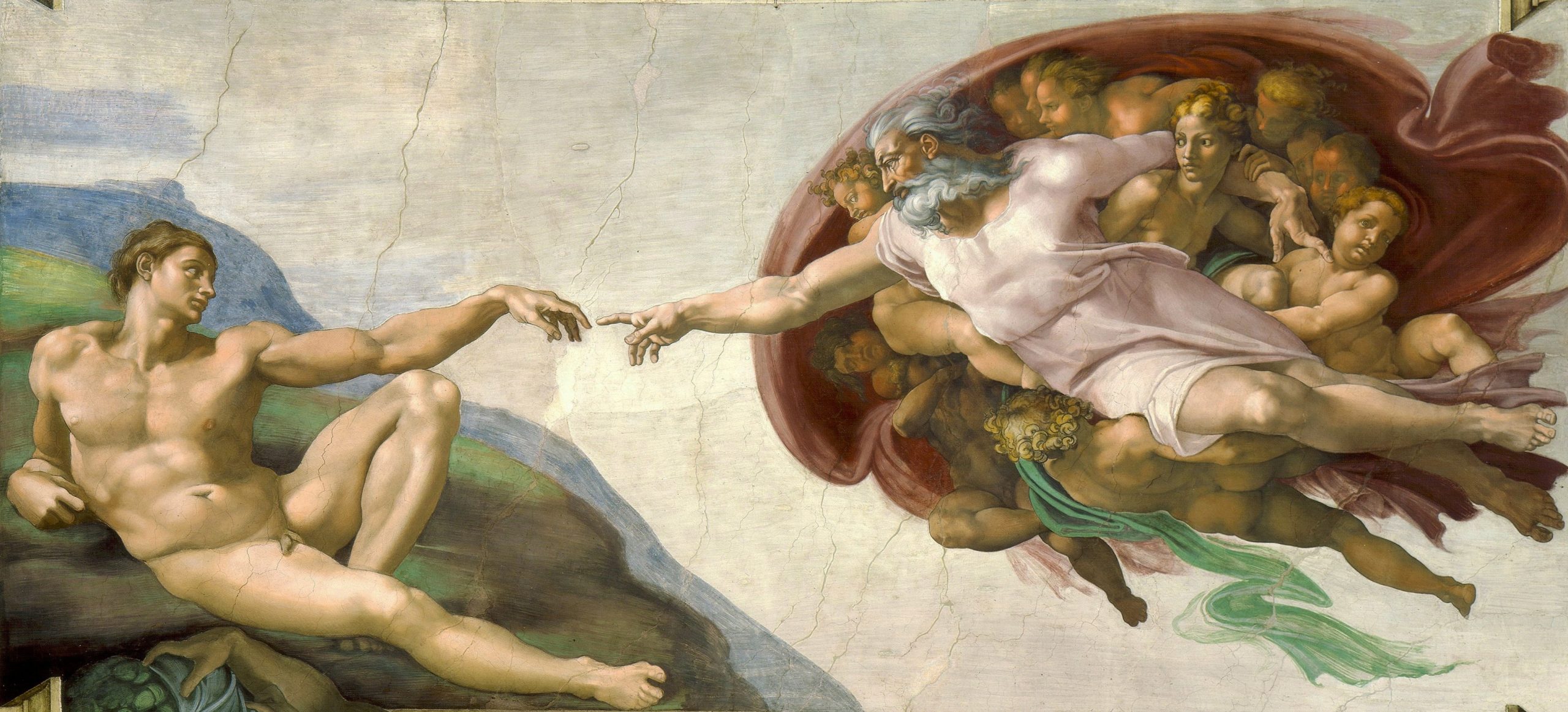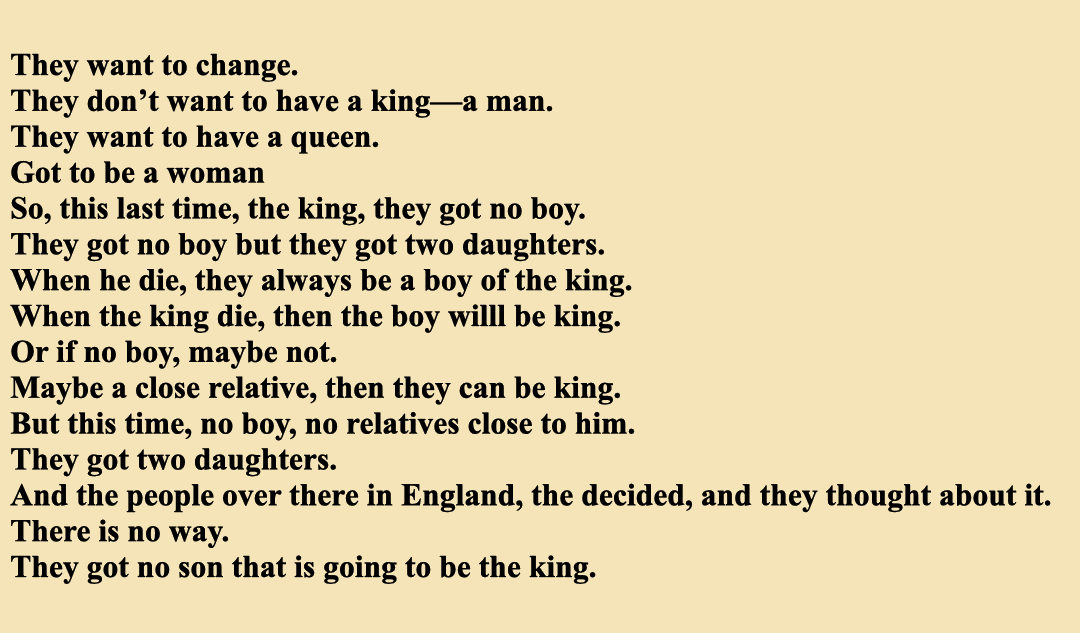What are the major differences or similarities between the ethos of the creation story or stories you are familiar with and the story King tells in The Truth About Stories ?
“Personally, I’d like to hear a creation story, a story that recounts how the world was formed, how things came to be, for contained within creation stories are relationships that help to define the nature of the universe and how cultures understand the world in which they exist.”
(King, 10)
I chose here to discuss the story of Charm alongside the greek myths, and a condensed version of the biblical account. This is because I have already discussed the Biblical story of creation in another post, so I felt that it would add little to the discussion. In addendum, I have analyzed a bonus creation story in addition to these two, which I think blends the philosophies found within the Biblical and Greek accounts very nicely.
There was Chaos.

There are different accounts and different interpretations of the early days of Greek myth and theogony. But the most well known and highest regarded is the works of Hesiod, specifically The Theogony, which details the genealogy of the Greek Gods, all descendants of six gods, the most powerful of which are Chaos, Gaia, and Eros. (II 116-138)
For most of the Homeric mythology that we are most accustomed to, these three gods have largely left the story, as have most of the others before the arrival of the Titans on mount Olympus. However, in the early days of the myths, they were responsible for the birth and creation of the world, and the many gods and creatures who would later rule it. Gaia created Uranus (the sky), Ourea (the mountains), and Pontus (the sea); as well as the many Gods and Goddess that would form the Titans. (Hesiod, II 116-138)
The Titans, no longer bound to Gaia, began taming the world, and adding more gods to it. These gods were in charge of their own domains: Epimetheus and Prometheus respectively created animals and humans, and gave them each different qualities distinct from each other; Athena was the goddess of wisdom and reason; Hades was the God of the underworld, and his “wife,” Persephone, was the goddess of spring.
As such, the creation story of Greek mythology is an explainer for how the gods that look after all that we know in the world came to be, which is not entirely different form the creation of the world, itself.
God Created the heavens and the earth.

Around the same time in region of Mesopotamia, another group of gods were being worshipped. One god, particularly holy to the Canaanites was the god who would come to be known as Yahweh. (Held) The exact origin of this god is contested, but the general understanding is that Yahweh was one god among many within the region, with stories and artifacts that have since been lost to time and conflict and the changing politics of history.
In the Judeo-christian tradition, the world started without form, and void. It was God, Yahweh, who brought the world into being, and through a symbolic passage of 7 days, Yahweh on his own created everything as it is. Through his will, Yahweh created light, the sky, the sea and dry land, vegetation, plants, fruits, and trees, the sun and the moon, birds and fish, and land animals and humans all within that week.
Adam and Eve, the first humans were in charge of the garden of Eden, and all the animals that lived within it. The two gave each of the animals names, following gods will. However, when God asked the two not to eat from the fruit of one of the trees in the garden, as it would give them knowledge of good and evil, the curiosity got the better of them and they denied gods will. As punishment for eating this fruit, Adam and Eve were sent out of the garden to fend for themselves in the wilderness.
The world we know as earth was nothing but water.
“In the beginning of imagination, the world that we know as earth was nothing but water, while above the earth, somewhere in space, was an older more ancient earth.
(King, 10)
In this older world, a curious, pregnant woman named Charm was going for a walk. While on her walk she encountered a hole in the base of a tree that she became curious about, wondering if it had something for her to eat. So she stuck her head in, and fell through. Because this older world sat above the newer world of water, she was surprised to suddenly find herself in the sky, falling towards a vast, endless ocean.
The flying animals of this world flew up and caught her, and rested her on the back of a sea turtle. Immediately all the animals started to look for a solution, because they knew that she couldn’t live on the sea turtle forever. So, Charm asked the swimming animals to get her some dirt that she could use for magic. Many animals dove down as far as they could, but only the otter managed to go down far enough to bring back a clump of dirt.
Charm thanked the animals, and used her magic and this dirt to create land, just in time to give birth to a pair of twins. These twins started shaping the land, making it flat, and building up hills and mountains, digging trenches to make rivers, made trees and flowers, the seasons, and the sun.
Analysis of Greek and Judeo-Christian Gods
The Ancient Greek Mythology paints a picture of a world that is ruled by character, where the attributes of the world are anthropomorphized. It shows how the world is made by people. People who are seemingly all-powerful, undying, and who have dominion in a way that we cannot understand. But still, people, with human emotions, and human flaws, and interact with each other as humans.
In comparison to the Biblical account where Yahweh alone exercised power and agency, an understanding of creation that incorporates the imperfections and trivialities of human personality within these conflicting sources of power is strikingly different. The world of greek mythology is also inherently political, focusing on the ways that different powers conflict. But because the world of judeo-christian creation does not feature a number of gods with conflicting interests, all the power and will is focused on one, all-powerful, all-knowing, and all-good creator.
Because of this focusing in power, the idea of morality is thought of largely different as well. the Ancient Greek world is constructed from deities who are just trying to find solutions to their problems — sometimes to the detriment of human kind, sometimes to each other —humanity does not hold the same communal expectations towards the deity of the Canaanites. Instead, humanity is subject to God, and the morality that is taught is that you can be a good person by following Him, alone.
Charm
You may have noticed that the way that I wrote the summary the Biblical creation story and the creation in Greek Myths is significantly different from how I wrote the summary for Charm. Where for the former two I focused on the general state of things, the facts of these particular histories — who had power, what did they do with it, how did they delegate — Charm’s summary focused on the journey that Charm took. This is because Charms story resists compression in a very unique way. Where the former two revolved around the systems at play, who had power, and how do you access it, Charm’s was focused on not on the systems in the world, but on the decisions of a character within it. It was a story!
This may be an artifact of King’s unique style. We can tell from his writing in Green Grass Running water that his work is character-driven, focusing on the intricacies of these interacting characters, the unique qualities of ‘I says’ and Coyote, and the mystery behind the Old Indians throughout. But even with this in mind, there was not a nice and easy way of dissecting this story into its main parts the way that we can in Genesis and the Greco-Roman Pantheon.
Throughout this story, too, is the confusion of time in various ways. In the beginning Charm only has suspicions that she might be pregnant, but by the time she is on the the newly created land, she has given birth to her twins. The passage of time unfolds without the characters or the audience really being aware of it. Perhaps it took the animals a really long time to find the dirt underwater. Perhaps she was just falling for a long time. Perhaps time simply did not behave the same way on an earth without a sun. What is left with the audience is a sense that time is flying.
Further, this mystery of time also alludes to the cyclical nature of time within stories in the indigenous worldview that King is discussing. In the colonized worldview there is an expectation of an absolute beginning to time. This may come from the religious idea of God creating the heavens and the earth, as discussed above, or from the Aristotelian and pre-socratic philosophies of an unmoved mover, but engrained in the European worldview is the idea that not only is the the past is finite, but there also has to be a cause for this finite past. In the modern worldview focused on the capabilities of science, this spiritual understanding of a limited past is embedded in cosmological concepts such as the Big Bang Theory.
However, many cultures around the world have had, and continue to have, an understanding of an infinite or cyclical past without concern. In many indigenous cultures, this past is signified by the cyclical concept of time, where all things have four overlapping phases of life. This is perhaps why King starts the story of creation by having Charm standing and living on a completely different world. In any other kind of story, this would beg the question, of where that world came from, too. But this way of telling the story allows for the audience to understand that this may have happened before, and it may happen again. This philosophy of embracing you curiosity even when it may not give you the answers you are looking for is echoed by Charm’s conversation with the moose at the beginning:
Hello, said the Moose. Aren’t you that nosy woman?
Yes, I am, said the woman, and what I want to know is why you are so much larger than me.
That’s easy, said the Moose, and he walked into the lake and disappeared.
(King, 11)

This interaction, and the unanswered questions of cosmology fit in with the indigenous ways of knowing and being, and specifically echoes the First Peoples Principles of Learning, specifically, the concept that “learning involves recognizing that some knowledge is sacred and only shared with permission and/or in certain situations.” This story not only teaches us about the concepts of community and cooperation, or the structure of indigenous storytelling, but also about the expectations of what kinds of things can be learned, and what kinds of questions demand answers.
Conclusions?
The worldviews of these three cultures informs and is informed by the stories that they tell. One could imagine the world of Greek myths and the Judeo-christian religion being told early on by people living in an area that was being surrounded by conflicting powers and wars, and trying to make sense of the chaos in various ways. And trying to find meaning in the damage being done around them by seemingly cold and impassive rulers. Where the greek mythology embraced the chaos in order to understand it, the judeo-christian belief attempted to find order within it.
But the world of Charm seems to be told from a community who finds their own survival to be determined by cooperation and respect, where people work together to find a shared understanding of how they can make the world better for others. It comes from a culture that embraces a continuance of nature that has existed through time immemorial, and must continue to exist eternally. It comes from a culture that encourages growth and learning and curiosity, but also puts limits within that to ensure the focus is remains on the world before them.
“Aristotle’s Prime Mover Explained” YouTube, uploaded by Philosophy Vibe, 26 Apr 2020. https://www.youtube.com/watch?v=SE8OPfCh2iY
The Bible. The New Revised Standard Version with Apocrypha. Hendrickson Publishers, 1993.
D’Aulaire, Ingri. “D’Aulaires’ Book of Greek Myths” Random House Children’s Books. 1992. Print.
“First People’s Principles of Learning.” First Nations Educational Steering Committee, http://www.fnesc.ca/first-peoples-principles-of-learning/ Accessed 19 Mar 2021
Held, Shai. “How YHWH Became God.” The Wall Street Journal. 11 Mar. 2016. Web. https://www.wsj.com/articles/how-yhwh-became-god-1457732366
Hesiod, “The Works and Days and Theogony,” ReadHowYouWant. 2008. eBook.
Joachim Wtewael. Battle Between the Gods and the Titans. 1613. Art Institute of Chicago, Chicago. Art Institute of Chicago. https://www.artic.edu/artworks/105466/the-battle-between-the-gods-and-the-giants
King, Thomas. “The Truth About Stories.” House of Anansi Press. 2003.
Michelangelo. The Creation of Adam. 1512. The Sistine Chapel, Rome. https://www.museivaticani.va/content/museivaticani/en/collezioni/musei/cappella-sistina/volta/storie-centrali/creazione-di-adamo.html

 (76)
(76)
